
Boraginaceae, the borage or forget-me-notfamily, includes about 2,000 species of shrubs, trees, and herbs in 146 to 154 genera with a worldwide distribution.

In the botanical classification of plants, Aeridinae Pfitzer is a subtribe of the tribe Vandeae whose representatives all have a monopodial growth habit and do not possess pseudobulbs.
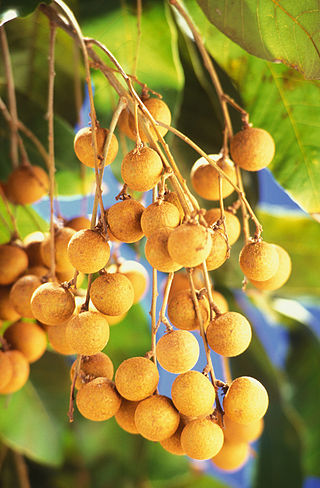
Dimocarpus is a genus of trees or shrubs in the flowering plant family Sapindaceae. It includes 7 species which grow naturally in tropical south and Southeast Asia, Malesia, Papuasia, and Australasia, including Sri Lanka, India, the Philippines, southern China, Taiwan, Myanmar, Cambodia, Vietnam, Malaysia, Indonesia, New Guinea, East Timor, far north-eastern Queensland, Australia.

Baccaurea is a genus of flowering plants belonging to the family Phyllanthaceae. The genus comprises 51 species, distributed from India to Indochina, southern China, Malesia, New Guinea, and the West Pacific. It is dioecious, with male and female flowers on separate plants. Many species contain edible fruits.
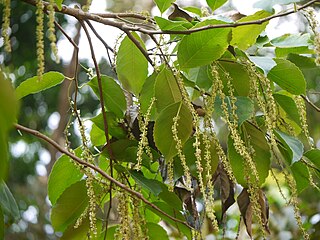
Homalium is a genus of plants in the family Salicaceae.

Knema is a genus of plant in family Myristicaceae, mostly consisting of small-medium trees found in lowland tropical forests from south and northeast of India, Indochina, Malay Archipelago to near the tip of New Guinea. The highest diversity of species is in Borneo in west of Malesia.

Streblus is a genus of flowering plants in the mulberry family, Moraceae. It includes five species native to the Indian subcontinent, Indochina, southern China, and Malesia.

Rhynchosia, also known as snoutbean, is a genus of plants in the family Fabaceae. It includes 260 species of herbs, vines, and subshrubs native to tropical, subtropical, and warm temperate regions around the world, ranging from the southern United States to northern Argentina in the Americas, and through Africa, the Arabian Peninsula, southern Asia from Iran to Korea and Japan, New Guinea, and Australia. Typical habitats include seasonally-dry forest, forest margins, woodland, thicket, wooded grassland, shrubland, and grassland, often in open rocky areas, disturbed areas, or along streams. Many species are pyrophytes. There are several different complexes within the genus, including the Senna complex.

Randia, commonly known as indigoberry, is a mostly Neotropical genus of shrubs or small trees in the Rubiaceae. As of February 2022 Plants of the World Online lists a total of 112 accepted species in the genus. Several Australian species have been reassigned to the genus Atractocarpus. These include the garden plants Atractocarpus chartaceus and A. fitzalanii.
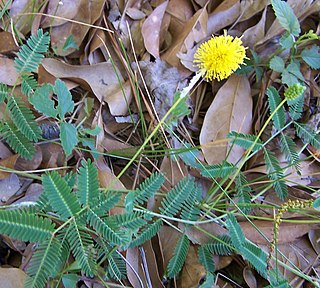
Neptunia is a genus of flowering plants in the family Fabaceae. It belongs to the mimosoid clade of the subfamily Caesalpinioideae.
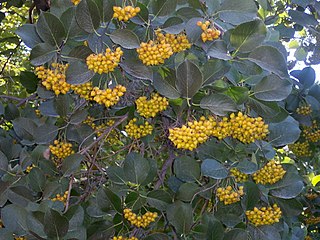
Ehretioideae is a subfamily of the flowering plant family Boraginaceae.
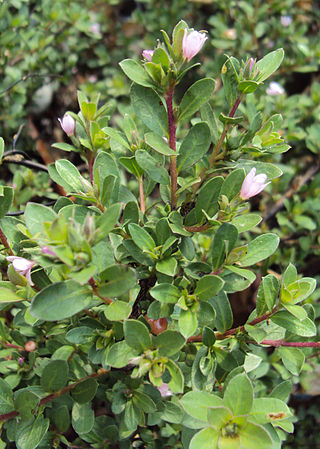
Rotula aquatica is a species of aromatic flowering shrub in the family Boraginaceae. It is a rare rheophyte native to India, where it is a member of the lotic ecosystem of streams.
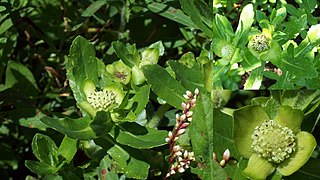
Enydra is a genus of flowering plants in the Asteraceae, or daisy, family. They are native to the Asian, African and American Tropics and Sub-Tropics.

Marasmius rotula is a common species of agaric fungus in the family Marasmiaceae. Widespread in the Northern Hemisphere, it is commonly known variously as the pinwheel mushroom, the pinwheel marasmius, the little wheel, the collared parachute, or the horse hair fungus. The type species of the genus Marasmius, M. rotula was first described scientifically in 1772 by mycologist Giovanni Antonio Scopoli and assigned its current name in 1838 by Elias Fries.

Schleichera is a monotypic genus of plants in the soapberry family, Sapindaceae. There is only one species, Schleichera oleosa, a tree that occurs in the Indian Subcontinent and Southeast Asia.

Litsea glutinosa is a rainforest tree in the laurel family, Lauraceae. Common names include soft bollygum, bolly beech, Bollywood, bollygum, brown bollygum, brown Bollywood, sycamore and brown beech.
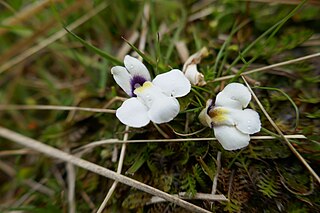
Mazaceae is a family of plants in the order Lamiales. The family was described by James L. Reveal in 2011. Genera in this family were most recently previously included in Phrymaceae and in older classifications were placed in Scrophulariaceae.
A rotula is a roll consisting of a long and narrow strip of writing material wound around a wooden axle or rod and written on its interior side.
Solena is a genus of flowering plants belonging to the family Cucurbitaceae.
Picria fel-terrae is a species of flowering plant belonging to the family Linderniaceae. It is the sole species in genus Picria..

















